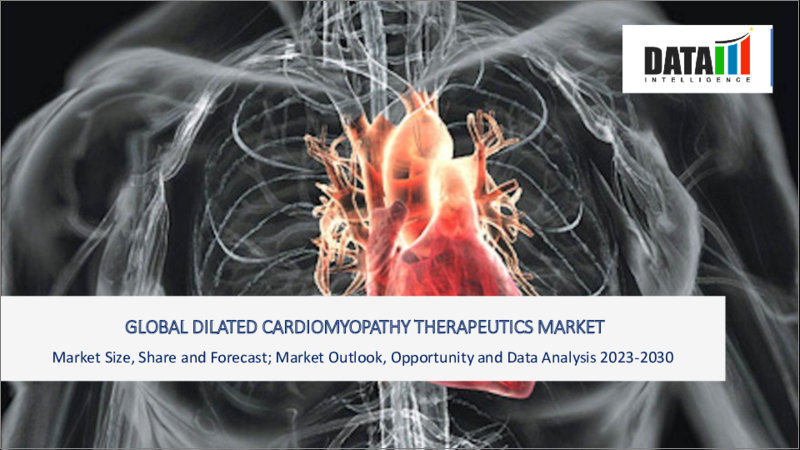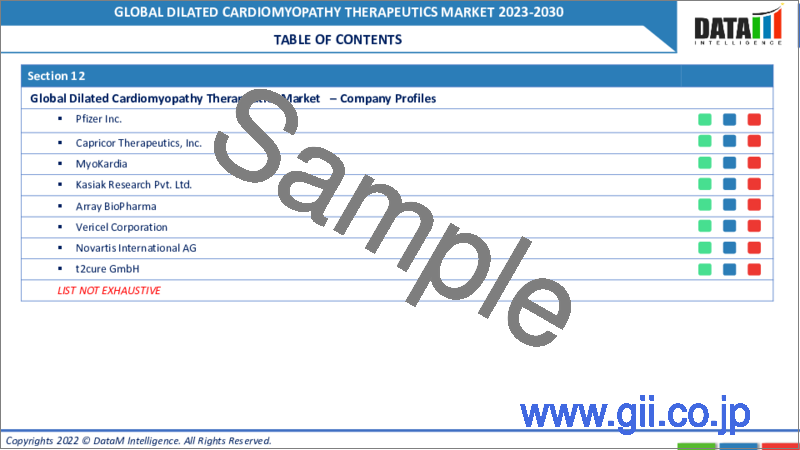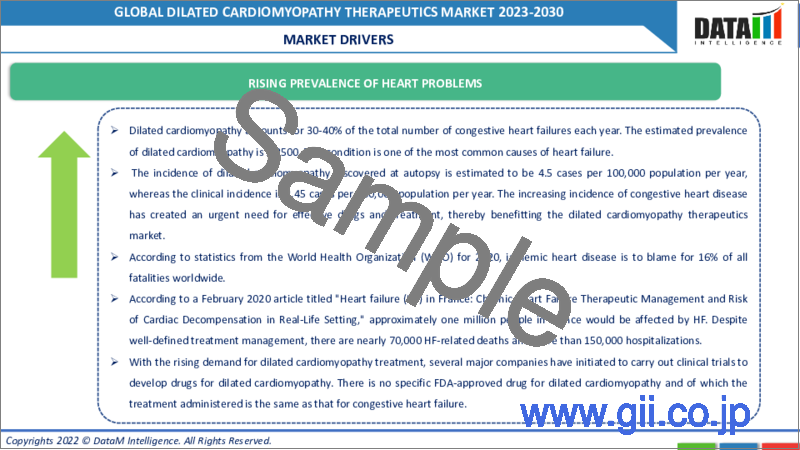|
|
市場調査レポート
商品コード
1140663
拡張型心筋症治療の世界市場-2022-2029年Global Dilated Cardiomyopathy Therapeutics Market - 2022-2029 |
||||||
|
● お客様のご希望に応じて、既存データの加工や未掲載情報(例:国別セグメント)の追加などの対応が可能です。 詳細はお問い合わせください。 |
|||||||
| 拡張型心筋症治療の世界市場-2022-2029年 |
|
出版日: 2022年10月20日
発行: DataM Intelligence
ページ情報: 英文 180 Pages
納期: 約2営業日
|
- 全表示
- 概要
- 目次
市場概要
拡張型心筋症治療の市場規模は、2021年に4億490万米ドルに達し、予測期間(2022-2029年)にCAGR5.90%で成長すると予測されています。
拡張型心筋症(DCM)は、心筋の異常であり、通常は心臓の主要なポンプ室(左心室)から始まります。心室は弱くなり、肥大化し、血液を送り出すことができなくなります。心不全の一般的な原因は、心臓が十分な血液を体に供給できないことですが、拡張型心筋症は不整脈、血栓、または突然死の原因ともなっています。拡張型心筋症は、乳幼児や小児を含むすべての年齢層が罹患しますが、20~50歳の男性に最も多くみられます。
市場力学
世界の拡張型心筋症治療市場の成長は、心臓疾患の有病率の上昇、心筋感染症に苦しむ人々の増加、薬物・アルコール乱用などの特定の要因に牽引されています。
心臓疾患の有病率の上昇は、予測期間中、世界の拡張型心筋症治療市場を牽引すると予想されます。
拡張型心筋症は、毎年のうっ血性心不全の総数の30~40%を占めています。拡張型心筋症の推定有病率は1:2500です。この疾患は、心不全の最も一般的な原因の1つです。剖検で発見された拡張型心筋症の発生率は、人口10万人あたり年間4.5例と推定されるが、臨床的な発生率は人口10万人あたり年間2.45例です。うっ血性心疾患の増加により、効果的な薬剤や治療法の緊急性が高まっており、拡張型心筋症治療市場の利益につながっています。
世界保健機関(WHO)の2020年の統計によると、虚血性心疾患は世界の全死亡者の16%の原因となっています。フランスにおける心不全(HF)」と題された2020年2月の記事によると。Chronic Heart Failure Therapeutic Management and Risk of Cardiac Decompensation in Real-Life Setting」によると、フランスでは約100万人がHFに罹患していることになります。治療管理が十分に確立されているにもかかわらず、HFに関連する死亡者数は約7万人、入院者数は15万人以上となっています。
拡張型心筋症の治療に対する需要が高まる中、いくつかの大手企業が拡張型心筋症の治療薬を開発するための臨床試験を開始しました。拡張型心筋症は、FDAが承認した特定の薬剤がないため、うっ血性心不全と同様の治療が行われます。
拡張型心筋症の治療薬として新たに開発された薬剤には、以下のようなものがあります。
ARRY-371797(別名ARRY-797)は、Array社の科学者が発見した経口のp38マイトジェン活性化プロテインキナーゼ(MAPK)阻害剤です。Lamin A/C遺伝子変異が原因で拡張型心筋症に罹患している患者の治療を目的として、第III相試験を実施中です。2019年、ファイザーはパイプラインを拡大するためにArray Biopharmaを買収しました。本剤は、拡張型心筋症に罹患した患者の治療を目的として、PF-07265803の名称でファイザーの第III相パイプライン医薬品に採用されています。
2020年2月、慶應義塾大学の研究チームが、iPS細胞由来の心筋細胞を重症心不全を経験した患者に移植することにゴーサインを出しました。2020年内の研究実施を目指し、心筋細胞の収縮機能が低下する拡張型心筋症の患者を対象とします。
拡張型心筋症治療薬に伴う副作用が市場成長の阻害要因に
しかし、患者に深刻な不快感を与える拡張型心筋症治療薬の副作用は、市場の抑制要因となっています。さらに、移植可能なデバイスや有望な遺伝子治療の利用が、市場の障害となっています。
産業分析
世界の拡張型心筋症治療市場は、ポーターの5力分析、パイプライン分析、規制分析、疫学、アンメットニーズなど、さまざまな産業要因に基づく市場の詳細な分析を提供します。
セグメント別分析
薬物クラスセグメントは、予測期間中(2022-2029年)に最も速いCAGRで成長すると予想されます。
拡張型心筋症治療薬市場は、薬物クラスに基づいて、アンジオテンシン変換酵素(ACE)阻害薬、β遮断薬、アルドステロン拮抗薬、アンジオテンシンII受容体遮断薬、その他に分類されます。アンジオテンシンII受容体拮抗薬は、特に先進地域において拡張型心筋症治におけるブロックバスター薬の需要が高まっていることから、最大の市場シェアを占めると予測されます。
一方、アルドステロン拮抗薬は、ARBまたはACE阻害薬との併用によりデュシェンヌ型筋ジストロフィー(DMD)の進行を抑制する効果が確認されており、予測期間中に最も高いCAGRで成長すると予測されます。この適応症の承認は、アルドステロン拮抗薬全体の売上をさらに加速させ、市場成長にプラスの影響を与えるでしょう。いくつかの研究によると、バルサルタンなどのアンジオテンシン受容体拮抗薬は、入院の確率を28%減少させることができます。これらの薬剤は、死亡を37%減らし、入院の頻度を減らすことで、収縮期心疾患の患者にも有効です。一般的な抗不整脈薬には、アミオダロン、プロカインアミド、リドカインなどがあります。Corlanorは、過分極活性化環状ヌクレオチドゲートチャネル遮断薬で、心臓の洞房結節の自発的ペースメーカー活性を低下させるものです。6カ月から18歳までの小児患者における拡張型心筋症に起因する安定した症状の心不全(HF)治療薬としてのCorlanor(イブラジン)の米国FDA承認は、洞調律の症候性DCM、NYHA/RossクラスIIからIV HF、左室駆出力45%以下の6カ月から18歳未満の患者116人における無作為二重盲検プラセボ対照試験に基づいていました。主要評価項目は、最初の漸増期間後、徐脈や症状を伴わない安静時心拍数がベースラインから20%以上減少したことでした。
地域分析
世界の拡張型心筋症治療薬市場において、北米地域が最大の市場シェアを占めています。
心血管疾患の発生率の上昇、確立された保険政策、高度なヘルスケアインフラの利用が主な要因となっています。米国では、2020年におけるHFの総医療費(直接費および間接費)は436億米ドルと推定され、その70%以上が医療費に起因するとされています。この地域では、米国が最大の市場シェアを占めています。これは、高齢者人口の増加、同国における心臓疾患の増加により、同地域の需要を押し上げているためです。したがって、心血管疾患の増加に伴い、拡張型心筋症の市場も増加します。
その上、市場のプレーヤーは、拡張型心筋症の新しい治療薬を実施するための研究開発に投資しています。例えば、2019年7月、人工知能を使って創薬を行うRecursion Pharmaceuticalsは、Baillie Giffordが主導するラウンドで1億2100万米ドルを調達しています。同社は2018年に資金調達を行った新しい創薬スタートアップで、この分野には、コンピュータビジョンや機械学習などの技術によって、コストと手間のかかる創薬プロセスが変革されることを期待する投資家が集まっています。リカーシオンは、希少疾患については自社で薬を作り、その他の希少疾患については武田薬品やサノフィなどの大手製薬会社と提携しようとしており、オンコロジーや炎症などの分野で製薬会社と契約を結びたいと考えています。
競合情勢
世界の拡張型心筋症治療市場は、Zensun Shanghai Sci &Tech Co Ltd、Capricor Therapeutics, Inc、AstraZeneca plc、Vericel Corporation、Pfizer Inc、t2cure GmbH、MyoKardia、Kasiak Research Pvt. Ltdなどの複数の主要プレーヤーによる中程度の競争状態にあります。大手企業は、製品の上市、買収、提携など、複数の成長戦略を採用しており、世界の拡張型心筋症治療市場の成長に寄与しています。例えば、2019年10月、ノバルティスは、1歳以上の小児患者における全身性左室収縮機能障害を伴う症候性心不全(HF)の治療薬として、Entresto(サキュビットリル/バルサルタン)の米国食品医薬品局(FDA)承認を取得しました。EntrestoはNT-proBNPを低下させ、心血管系の予後を改善することが期待されています。
主な注目企業
ファイザー株式会社
概要ファイザー株式会社は、米国の多国籍製薬企業で、がん、炎症、循環器、その他の治療領域における医薬品、ワクチン、医療機器、コンシューマーヘルスケア製品を提供しています。ファイザー株式会社は、15の治療領域において150以上の製品ポートフォリオを有しています。同社は、免疫学、腫瘍学、循環器学、内分泌学、神経学など、幅広い医療分野向けの医薬品やワクチンを開発・製造しています。
製品ポートフォリオカムジオスは、心筋症の患者さんにとって初めて利用できる新規治療の選択肢です。
主な発展。2022年8月、ファイザーは拡張型心筋症治療薬エンプルマピモドの開発を中止しました。
世界の拡張型心筋症治療市場レポートでは、約40以上の市場データ表、45以上の図、180ページの構成で提供しています。
目次
第1章 調査手法と調査範囲
- 調査手法
- 調査目的および調査範囲
第2章 市場の定義と概要
第3章 エグゼクティブサマリー
- 薬物クラス別市場内訳
- 流通チャネル別市場内訳
- 地域別市場内訳
第4章 市場の力学
- 市場影響要因
- 促進要因
- 心臓疾患の増加
- 薬物・アルコール乱用の増加
- 抑制要因
- 拡張型心筋症治療薬の副作用
- ビジネスチャンス
- 影響分析
第5章 産業分析
- ポーターのファイブフォース分析
- 疫学
- パイプライン分析
- 規制分析
- アンメットニーズ
第6章 薬物クラス別
- アンジオテンシン変換酵素(ACE)阻害剤
- β-ブロッカー
- アルドステロン拮抗薬
- アンジオテンシンII受容体拮抗薬
- その他
第7章 販売チャネル別
- 病院・クリニック
- オンラインチャネル
- その他
第8章 地域別
- 北米
- 米国
- カナダ
- メキシコ
- 欧州
- ドイツ
- 英国
- フランス
- イタリア
- スペイン
- その他欧州
- 南米
- ブラジル
- アルゼンチン
- その他の南米地域
- アジア太平洋地域
- 中国
- インド
- 日本
- オーストラリア
- その他アジア太平洋地域
- 中東・アフリカ地域
第9章 競合情勢
- 競合シナリオ
- 市況/シェア分析
- M&A(合併・買収)分析
第10章 企業プロファイル
- AstraZeneca plc
- 企業概要
- 製品ポートフォリオと説明
- 主なハイライト
- 財務概要
- Zensun Shanghai Sci & Tech Co Ltd
- Pfizer Inc.
- Capricor Therapeutics, Inc.
- MyoKardia
- Kasiak Research Pvt. Ltd.
- Array BioPharma
- Vericel Corporation
- t2cure GmbH(*List is not exhaustive)
第11章 DataM
Market Overview
Dilated Cardiomyopathy Therapeutics Market size was valued at US$ 404.9 million in 2021 and is estimated to reach US$ XX million by 2029, growing at a CAGR of 5.90% during the forecast period (2022-2029).
Dilated cardiomyopathy (DCM) is an abnormality of the heart muscle, usually starting in your heart's main pumping chamber (left ventricle). The ventricle becomes weakened and enlarged and can't pump blood. A common cause of heart failure is the heart's inability to supply the body with enough blood, and dilated cardiomyopathy also contributes to irregular heartbeats (arrhythmias), blood clots, or sudden death. People of all ages are affected by DCM, including infants and children, but it is most common in men ages 20 to 50.
Market Dynamics
The global dilated cardiomyopathy therapeutics market growth driven by certain factors such by rising prevalence of heart problems, the increasing number of people suffering from cardiac muscle infections, and drug or alcohol abuse.
Rising prevalence of heart problems, is expected to drive the global dilated cardiomyopathy therapeutics market during the forecast period
Dilated cardiomyopathy accounts for 30-40% of the total number of congestive heart failures each year. The estimated prevalence of dilated cardiomyopathy is 1:2500. This condition is one of the most common causes of heart failure. The incidence of dilated cardiomyopathy discovered at autopsy is estimated to be 4.5 cases per 100,000 population per year, whereas the clinical incidence is 2.45 cases per 100,000 population per year. The increasing incidence of congestive heart diseases has created an urgent need for effective drugs and treatment, thereby benefitting the dilated cardiomyopathy therapeutics market.
According to statistics from the World Health Organization (WHO) for 2020, ischemic heart disease is to blame for 16% of all fatalities worldwide. According to a February 2020 article titled "Heart failure (HF) in France: Chronic Heart Failure Therapeutic Management and Risk of Cardiac Decompensation in Real-Life Setting," approximately one million people in France would be affected by HF. Despite well-defined treatment management, there are nearly 70,000 HF-related deaths and more than 150,000 hospitalizations.
With the rising demand for dilated cardiomyopathy treatment, several major companies have initiated to carry out clinical trials to develop drugs for dilated cardiomyopathy. There is no specific FDA-approved drug for dilated cardiomyopathy because of which the treatment administered is the same as that for congestive heart failure.
Some of the emerging drugs for the treatment of dilated cardiomyopathy are:
ARRY-371797, also known as ARRY-797, is an oral, p38 mitogen-activated protein kinase (MAPK) inhibitor discovered by Array scientists. It is under phase III trial to treat patients suffering from dilated cardiomyopathy because of a Lamin A/C gene mutation. In 2019, Pfizer acquired Array Biopharma to expand its pipeline. This drug is in phase III pipeline drugs of Pfizer under the name PF-07265803 for the treatment of patients affected by dilated cardiomyopathy.
In February 2020, a Keio University research team was given the green light to transplant heart muscle cells derived from iPS cells into patients who have experienced severe heart failure. The study aims to conduct study by the end of 2020 and targets patients with dilated cardiomyopathy, which lowers the systolic function of heart muscle cells.
Side effects associated with dilated cardiomyopathy therapeutics hampering the growth of the market
However, the side effects of dilated cardiomyopathy therapeutics that cause serious discomfort to the patients are restraining the market. Moreover, the availability of implantable devices and promising gene therapy are acting as roadblocks to the market.
Industry Analysis
The global dilated cardiomyopathy therapeutics market provides in-depth analysis of the market based on various industry factors such as porter's five force analysis, pipeline analysis, regulatory analysis, regulatory analysis, epidemiology, unmet needs etc.
Segment Analysis
The drug class segment is expected to grow at the fastest CAGR during the forecast period (2022-2029)
Based on drug class, the dilated cardiomyopathy therapeutics market is segmented by drug class into angiotensin-converting enzyme (ACE) inhibitors, beta-blockers, aldosterone antagonists, angiotensin II receptor blockers, and others. The angiotensin II receptor blockers drug class is estimated to account for the largest market share, owing to the rising demand for blockbuster drugs in dilated cardiomyopathy treatment, especially in developed regions.
On the other hand, the aldosterone antagonists are expected to grow at the highest CAGR over the forecast period due to the identified positive impact of aldosterone antagonists when used in combination with either ARBs or ACE inhibitors in reducing the progression of Duchenne muscular dystrophy (DMD). Approval for this indication would further accelerate the overall sales of aldosterone antagonists, which would positively impact market growth. According to some studies, the angiotensin receptor blockers such as valsartan can reduce the probability of hospitalization by 28%. These drugs are also effective for patients with systolic heart disease by reducing deaths by 37% and reducing hospitalization frequency. Common anti-arrhythmia medications include amiodarone, procainamide, and lidocaine. Corlanor is a hyperpolarization-activated cyclic nucleotide-gated channel blocker that reduces the cardiac sinus node's spontaneous pacemaker activity. The US FDA approval of Corlanor (ivabradine) for the treatment of stable symptomatic heart failure (HF) due to dilated cardiomyopathy in pediatric patients aged 6 months to 18 years was based on a randomized, double-blind, placebo-controlled trial in 116 patients aged 6 months to less than 18 years with symptomatic DCM in sinus rhythm, NYHA/Ross class II to IV HF, and left ventricular ejection fraction ≤45%. The study's primary endpoint was ≥ a 20% reduction in resting heart rate from baseline without bradycardia or symptoms after an initial titration period.
Geographical Analysis
North America region holds the largest market share of the global dilated cardiomyopathy therapeutics market
The rising incidence of cardiovascular diseases, well-established insurance policies, and the availability of advanced healthcare infrastructure are the major factors. In the USA, the total cost of care (direct and indirect costs) for HF in 2020 is estimated at $43.6 billion, with over 70% of costs attributed to medical costs. In this region, the United States holds the largest market share due to rising geriatric populations, an increasing number of heart diseases in the country, which boosts the demand in this region. Hence, as the number of cardiovascular diseases increases, the market for dilated cardiomyopathy also increases.
Besides, the market players are investing in research and development to conduct new treatment drugs for dilated cardiomyopathy. For instance, in July 2019, Recursion Pharmaceuticals, which uses artificial intelligence to discover drugs, has raised $121 million in a round led by Baillie Gifford. The company is a new drug discovery start-up to raise funds in 2018, as investors flock to the sector hoping that the costly and cumbersome process of finding a drug will be transformed by techniques such as computer vision and machine learning. Recursion is trying to make its own drugs for rare diseases and partner with major pharmaceutical companies such as Takeda and Sanofi on other rare diseases, and hoping to sign deals with pharma companies in areas such as oncology and inflammation.
Competitive Landscape
The global dilated cardiomyopathy therapeutics market is moderately competitive with several major players, including Zensun Shanghai Sci & Tech Co Ltd, Capricor Therapeutics, Inc, AstraZeneca plc., Vericel Corporation, Pfizer Inc., t2cure GmbH, MyoKardia, Kasiak Research Pvt. Ltd., among others. The major players are adopting several growth strategies such as product launches, acquisitions, and collaborations, contributing to the growth of the dilated cardiomyopathy therapeutics market globally. For instance, in October 2019, Novartis received the U.S. Food and Drug Administration (FDA) approval for Entresto (sacubitril/valsartan) for the treatment of symptomatic heart failure (HF) with systemic left ventricular systolic dysfunction in pediatric patients aged 1 year and older. Entresto reduces NT-proBNP and is expected to improve cardiovascular outcomes.
Key Companies to Watch
Pfizer Inc
Overview: Pfizer Inc. is an American multinational pharmaceutical company that offers medicines, vaccines, medical devices, and consumer healthcare products for oncology, inflammation, cardiovascular, and other therapeutic areas. Pfizer Limited has a portfolio of over 150 products across 15 therapeutic areas. The company develops and produces medicines and vaccines for a wide range of medical disciplines, including immunology, oncology, cardiology, endocrinology, and neurology.
Product Portfolio: Camzyos is the first novel therapy option available for cardiomyopathy patients.
Key Developments: In August, 18th 2022, Pfizer discontinued the development of dilated cardiomyopathy drug emprumapimod.
The global dilated cardiomyopathy therapeutics market report would provide an access to an approx. 40+ market data table, 45+ figures and 180 pages.
Table of Contents
1. Methodology and Scope
- 1.1. Research Methodology
- 1.2. Research Objective and Scope of the Report
2. Market Definition and Overview
3. Executive Summary
- 3.1. Market Snippet by Drug class
- 3.2. Market Snippet by Distribution Channel
- 3.3. Market Snippet by Region
4. Market Dynamics
- 4.1. Market Impacting Factors
- 4.2. Drivers
- 4.2.1. Rising prevalence of heart diseases
- 4.2.2. Increasing drugs and alcohol abuse
- 4.2.3. XX
- 4.3. Restraints:
- 4.3.1. Side-effects of dilated cardiomyopathy drugs
- 4.3.2. XX
- 4.4. Opportunity
- 4.5. Impact Analysis
5. Industry Analysis
- 5.1. Porter's Five Forces Analysis
- 5.2. Epidemiology
- 5.3. Pipeline analysis
- 5.4. Regulatory Analysis
- 5.5. Unmet Needs
6. By Drug class
- 6.1. Introduction
- 6.2. Market Size Analysis, and Y-o-Y Growth Analysis (%), By Drug Class Segment.
- 6.3. Market Attractiveness Index, By Drug Class Segment
- 6.3.1. Angiotensin-converting enzyme (ACE) Inhibitors*
- 6.3.1.1. Introduction
- 6.3.1.2. Market Size Analysis, and Y-o-Y Growth Analysis (%)
- 6.3.2. Beta-blockers
- 6.3.3. Aldosterone antagonists
- 6.3.4. Angiotensin II Receptor Blockers
- 6.3.5. Others
- 6.3.1. Angiotensin-converting enzyme (ACE) Inhibitors*
7. By Distribution Channel
- 7.1. Introduction
- 7.2. Market Size Analysis, and Y-o-Y Growth Analysis (%), By Distribution Channel Segment
- 7.3. Market Attractiveness Index, By Distribution Channel Segment
- 7.3.1. Hospitals & Clinics*
- 7.3.1.1. Introduction
- 7.3.1.2. Market Size Analysis, and Y-o-Y Growth Analysis (%)
- 7.3.2. Online Channels
- 7.3.3. Others
- 7.3.1. Hospitals & Clinics*
8. By Region
- 8.1. Introduction
- 8.1.1. Market Size Analysis, and Y-o-Y Growth Analysis (%), By Region
- 8.1.2. Market Attractiveness Index, By Region
- 8.2. North America
- 8.2.1. Introduction
- 8.2.2. Key Region-Specific Dynamics
- 8.2.3. Market Size Analysis, and Y-o-Y Growth Analysis (%), By Drug Class
- 8.2.4. Market Size Analysis, and Y-o-Y Growth Analysis (%), By Distribution Channel
- 8.2.5. Market Size Analysis, and Y-o-Y Growth Analysis (%), By Country
- 8.2.5.1. The U.S.
- 8.2.5.2. Canada
- 8.2.5.3. Mexico
- 8.3. Europe
- 8.3.1. Introduction
- 8.3.2. Key Region-Specific Dynamics
- 8.3.3. Market Size Analysis, and Y-o-Y Growth Analysis (%), By Drug Class
- 8.3.4. Market Size Analysis, and Y-o-Y Growth Analysis (%), By Distribution Channel
- 8.3.5. Market Size Analysis, and Y-o-Y Growth Analysis (%), By Country
- 8.3.5.1. Germany
- 8.3.5.2. The U.K.
- 8.3.5.3. France
- 8.3.5.4. Italy
- 8.3.5.5. Spain
- 8.3.5.6. Rest of Europe
- 8.4. South America
- 8.4.1. Introduction
- 8.4.2. Key Region-Specific Dynamics
- 8.4.3. Market Size Analysis, and Y-o-Y Growth Analysis (%), By Drug Class
- 8.4.4. Market Size Analysis, and Y-o-Y Growth Analysis (%), By Distribution Channel
- 8.4.5. Market Size Analysis, and Y-o-Y Growth Analysis (%), By Country
- 8.4.5.1. Brazil
- 8.4.5.2. Argentina
- 8.4.5.3. Rest of South America
- 8.5. Asia Pacific
- 8.5.1. Introduction
- 8.5.2. Key Region-Specific Dynamics
- 8.5.3. Market Size Analysis, and Y-o-Y Growth Analysis (%), By Drug Class
- 8.5.4. Market Size Analysis, and Y-o-Y Growth Analysis (%), By Distribution Channel
- 8.5.5. Market Size Analysis, and Y-o-Y Growth Analysis (%), By Country
- 8.5.5.1. China
- 8.5.5.2. India
- 8.5.5.3. Japan
- 8.5.5.4. Australia
- 8.5.5.5. Rest of Asia Pacific
- 8.6. The Middle East and Africa
- 8.6.1. Introduction
- 8.6.2. Key Region-Specific Dynamics
- 8.6.3. Market Size Analysis, and Y-o-Y Growth Analysis (%), By Drug Class
- 8.6.4. Market Size Analysis, and Y-o-Y Growth Analysis (%), By Distribution Channel
9. Competitive Landscape
- 9.1. Competitive Scenario
- 9.2. Market Positioning/Share Analysis
- 9.3. Mergers and Acquisitions Analysis
10. Company Profiles
- 10.1. AstraZeneca plc*
- 10.1.1. Company Overview
- 10.1.2. Product Portfolio and Description
- 10.1.3. Key Highlights
- 10.1.4. Financial Overview
- 10.2. Zensun Shanghai Sci & Tech Co Ltd
- 10.3. Pfizer Inc.
- 10.4. Capricor Therapeutics, Inc.
- 10.5. MyoKardia
- 10.6. Kasiak Research Pvt. Ltd.
- 10.7. Array BioPharma
- 10.8. Vericel Corporation
- 10.9. t2cure GmbH (*List is not exhaustive)
11. DataM Intelligence
- 11.1. Appendix
- 11.2. About Us and Services
- 11.3. Contact Us




